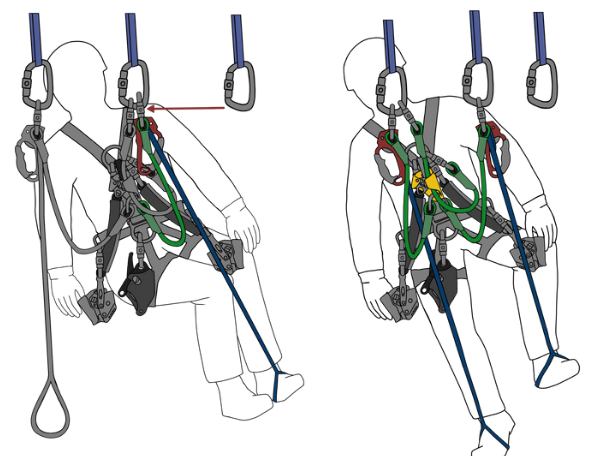Rope access techniques are essential across numerous industries, ensuring professionals can navigate difficult environments safely and efficiently. Whether working on industrial contracts or emergency rescue operations, mastering these techniques allows workers to meet the high standards expected in these roles. In this post, we’ll focus on four key techniques every professional needs and how they apply in real-world contracts and projects.
Key Rope Access Techniques in Action
1. Passing a Knot
Who Needs It: Industrial technicians, rescue teams. Why It Matters: When working on long-term maintenance contracts for wind farms, building inspections, or large-scale construction sites, knots are inevitable due to rope length requirements or the need to isolate damaged sections. Technicians must pass these knots smoothly to avoid delays and ensure continuous safety during operations.
Where It’s Applied: Picture a wind farm maintenance contract, where technicians regularly ascend and descend hundreds of feet to inspect turbines. Encountering knots where ropes have been spliced together is common. Without the ability to pass them efficiently, productivity suffers, and safety can be compromised.
2. Passing a Deviation
Who Needs It: Industrial inspection teams, rescue professionals. Why It Matters: Contracts for bridge inspections, oil platform maintenance, and high-rise building projects frequently involve ropes that need to be deviated from their natural path to avoid obstacles or reduce friction. Professionals must be able to pass deviations smoothly to protect the rope from damage and ensure the job remains on track.
Where It’s Applied: A government contract to inspect and maintain a large suspension bridge involves multiple deviations as the rope passes through support beams or around sharp edges. In these situations, managing deviations efficiently ensures both the rope’s longevity and the safety of the technician.
3. Horizontal Aid Climbing
Who Needs It: Pipeline workers, bridge maintenance crews, confined space specialists. Why It Matters: Many contracts, especially in industries like oil and gas, require professionals to navigate across long horizontal spaces. Horizontal aid climbing enables technicians to move laterally along pipelines, beams, or other structures, reducing the need to constantly descend and reposition, which saves time and improves efficiency.
Where It’s Applied: In a contract to inspect a series of offshore oil rigs, horizontal aid climbing allows workers to traverse platforms, pipelines, or confined spaces without needing to re-rig frequently. This not only increases productivity but ensures the inspection is completed within project deadlines.
4. Pick-Off from Descent
Who Needs It: Rescue teams, industrial safety professionals. Why It Matters: Contracts related to rescue operations, especially in industries like construction, oil, and telecommunications, require workers to be prepared for emergencies. Pick-offs from descent allow rescuers to retrieve an incapacitated worker efficiently and safely, a skill required for compliance with safety regulations.
Where It’s Applied: Consider a contract for a telecommunications tower inspection. If a worker becomes incapacitated, the rescue team must perform a pick-off from descent to safely lower the individual. Knowing how to perform this technique quickly and effectively can prevent further injuries and reduce liability for the company overseeing the project.
Why These Techniques Matter in Contracts
When working on large-scale industrial contracts or rescue projects, time, safety, and efficiency are paramount. The ability to pass knots and deviations, perform horizontal aid climbing, and execute pick-off rescues ensures that teams can meet contractual obligations without compromising on safety or project timelines. Mastering these techniques not only builds a reputation for reliability but also ensures compliance with industry standards and safety regulations.
Are you ready to enhance your rope access skills? Whether you’re preparing for high-stakes industrial contracts or rescue operations, our comprehensive course covers everything you need to know.
Subscribe today and get access to the knowledge and techniques that will set you apart in the field.
Peace on your Days
Lance










